Evaluating Nestle Maggi's Brand Elements, Marketing Mix & Equity
VerifiedAdded on 2022/09/05
|10
|2829
|47
Report
AI Summary
This report provides a comprehensive analysis of the Nestle Maggi brand, focusing on its key brand elements, marketing mix, and brand equity. It begins with an introduction to Nestle Maggi, highlighting its brand elements such as brand name, logo, and slogan, which contribute to brand recognition and consumer association. The report then evaluates Nestle Maggi's marketing mix, examining its product offerings, pricing strategies, distribution channels, and promotional activities, emphasizing its cost-based pricing strategy and extensive distribution network. Furthermore, it assesses Nestle Maggi's target market and positioning strategies, explaining how the brand aims to create a strong brand image and awareness. The analysis also identifies potential threats to Nestle Maggi's brand equity, including changing consumer preferences and market competition. The report concludes with recommendations to enhance Nestle Maggi's brand equity and image, providing valuable insights into the brand's strategic approach. Desklib provides a platform to explore more such solved assignments.
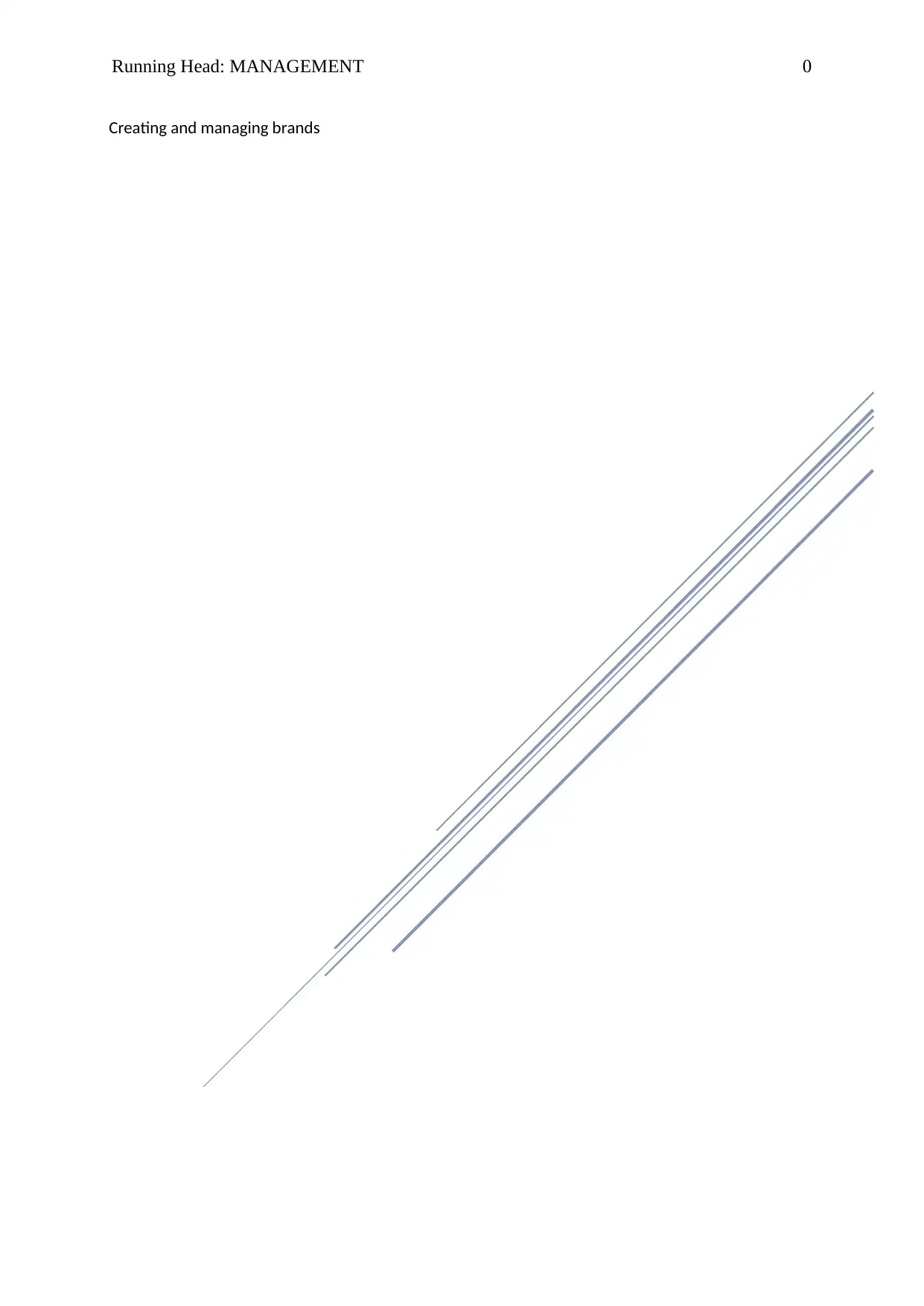
Running Head: MANAGEMENT 0
Creating and managing brands
Creating and managing brands
Paraphrase This Document
Need a fresh take? Get an instant paraphrase of this document with our AI Paraphraser
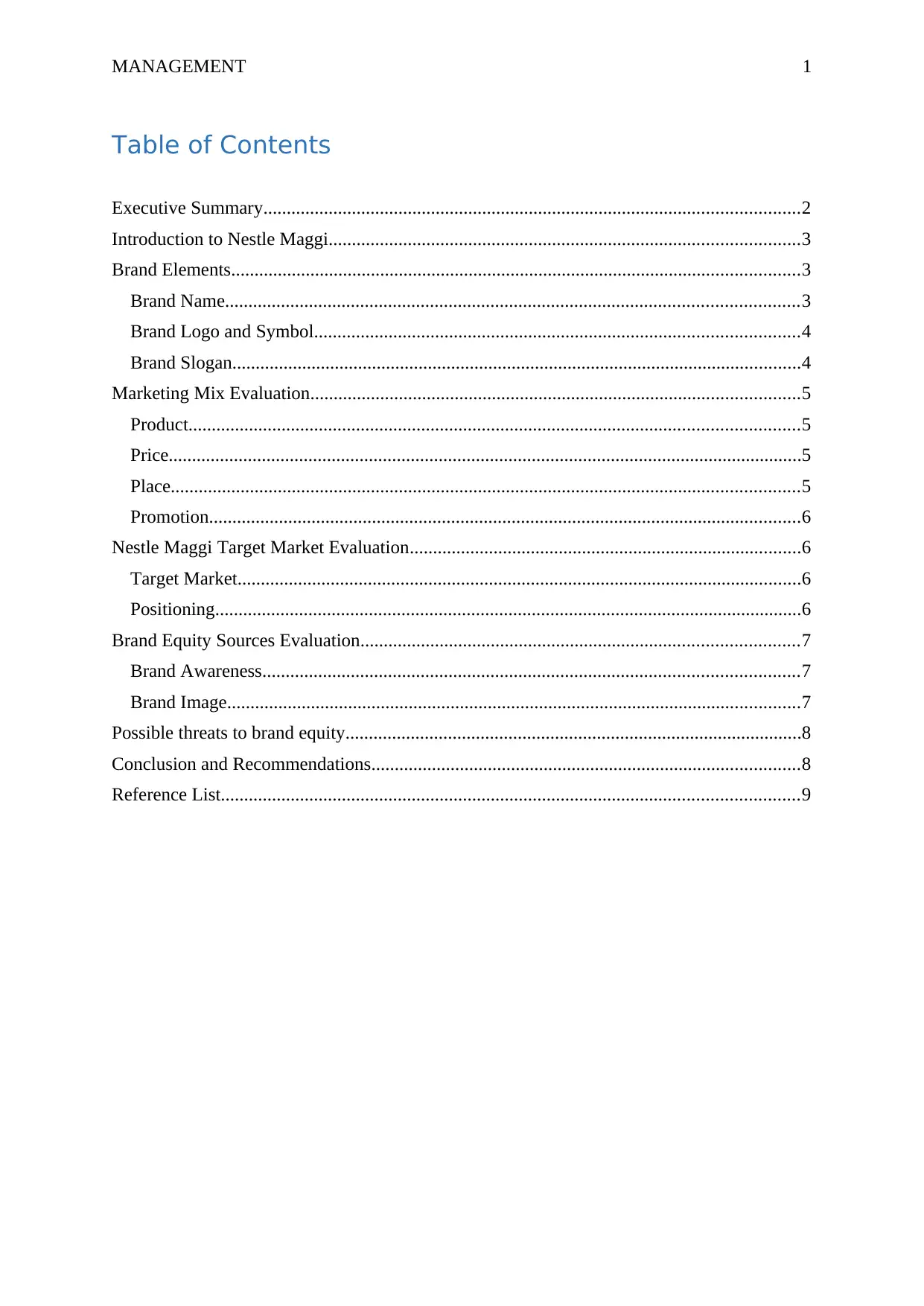
MANAGEMENT 1
Table of Contents
Executive Summary...................................................................................................................2
Introduction to Nestle Maggi.....................................................................................................3
Brand Elements..........................................................................................................................3
Brand Name...........................................................................................................................3
Brand Logo and Symbol........................................................................................................4
Brand Slogan..........................................................................................................................4
Marketing Mix Evaluation.........................................................................................................5
Product...................................................................................................................................5
Price........................................................................................................................................5
Place.......................................................................................................................................5
Promotion...............................................................................................................................6
Nestle Maggi Target Market Evaluation....................................................................................6
Target Market.........................................................................................................................6
Positioning..............................................................................................................................6
Brand Equity Sources Evaluation..............................................................................................7
Brand Awareness...................................................................................................................7
Brand Image...........................................................................................................................7
Possible threats to brand equity..................................................................................................8
Conclusion and Recommendations............................................................................................8
Reference List............................................................................................................................9
Table of Contents
Executive Summary...................................................................................................................2
Introduction to Nestle Maggi.....................................................................................................3
Brand Elements..........................................................................................................................3
Brand Name...........................................................................................................................3
Brand Logo and Symbol........................................................................................................4
Brand Slogan..........................................................................................................................4
Marketing Mix Evaluation.........................................................................................................5
Product...................................................................................................................................5
Price........................................................................................................................................5
Place.......................................................................................................................................5
Promotion...............................................................................................................................6
Nestle Maggi Target Market Evaluation....................................................................................6
Target Market.........................................................................................................................6
Positioning..............................................................................................................................6
Brand Equity Sources Evaluation..............................................................................................7
Brand Awareness...................................................................................................................7
Brand Image...........................................................................................................................7
Possible threats to brand equity..................................................................................................8
Conclusion and Recommendations............................................................................................8
Reference List............................................................................................................................9
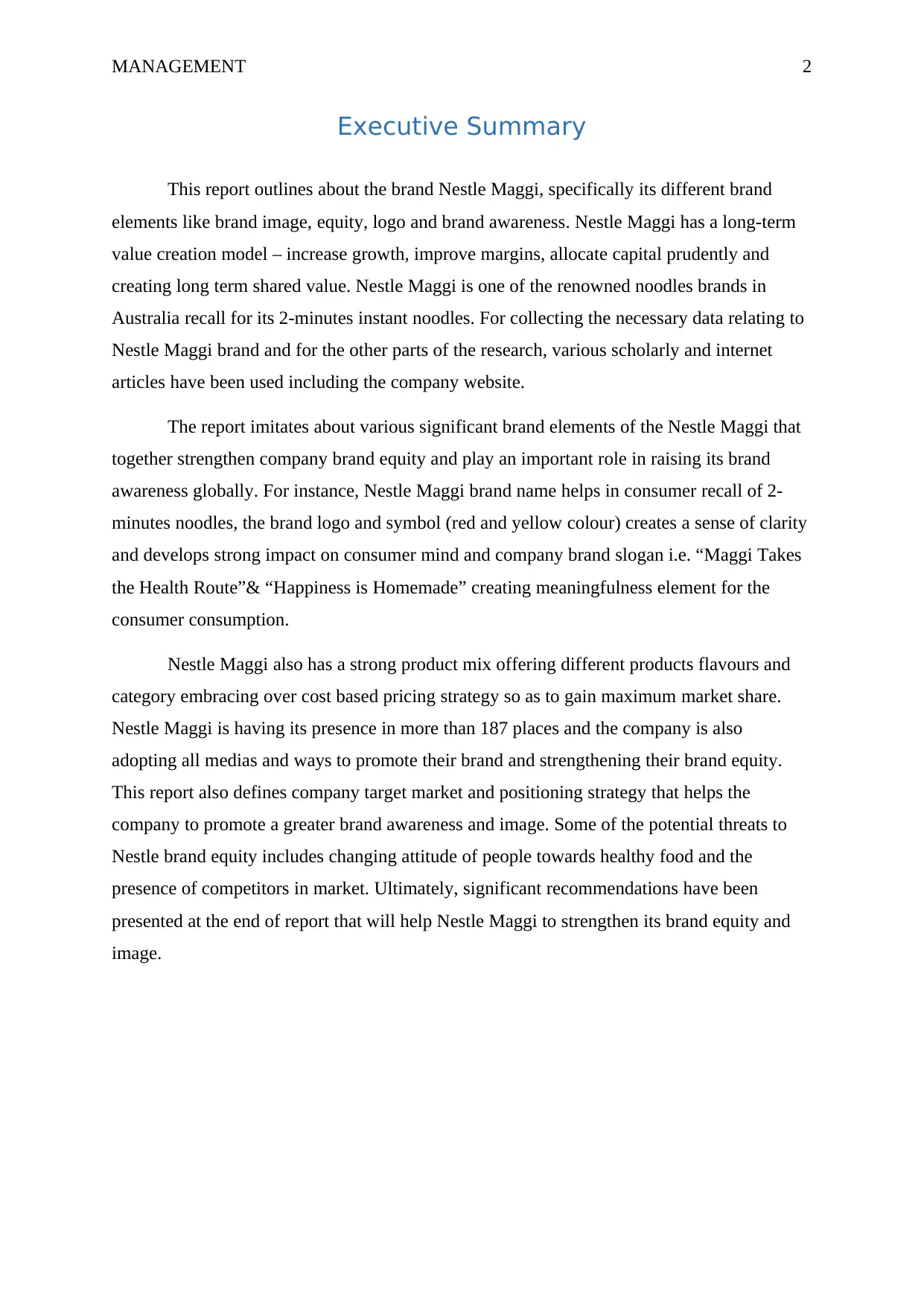
MANAGEMENT 2
Executive Summary
This report outlines about the brand Nestle Maggi, specifically its different brand
elements like brand image, equity, logo and brand awareness. Nestle Maggi has a long-term
value creation model – increase growth, improve margins, allocate capital prudently and
creating long term shared value. Nestle Maggi is one of the renowned noodles brands in
Australia recall for its 2-minutes instant noodles. For collecting the necessary data relating to
Nestle Maggi brand and for the other parts of the research, various scholarly and internet
articles have been used including the company website.
The report imitates about various significant brand elements of the Nestle Maggi that
together strengthen company brand equity and play an important role in raising its brand
awareness globally. For instance, Nestle Maggi brand name helps in consumer recall of 2-
minutes noodles, the brand logo and symbol (red and yellow colour) creates a sense of clarity
and develops strong impact on consumer mind and company brand slogan i.e. “Maggi Takes
the Health Route”& “Happiness is Homemade” creating meaningfulness element for the
consumer consumption.
Nestle Maggi also has a strong product mix offering different products flavours and
category embracing over cost based pricing strategy so as to gain maximum market share.
Nestle Maggi is having its presence in more than 187 places and the company is also
adopting all medias and ways to promote their brand and strengthening their brand equity.
This report also defines company target market and positioning strategy that helps the
company to promote a greater brand awareness and image. Some of the potential threats to
Nestle brand equity includes changing attitude of people towards healthy food and the
presence of competitors in market. Ultimately, significant recommendations have been
presented at the end of report that will help Nestle Maggi to strengthen its brand equity and
image.
Executive Summary
This report outlines about the brand Nestle Maggi, specifically its different brand
elements like brand image, equity, logo and brand awareness. Nestle Maggi has a long-term
value creation model – increase growth, improve margins, allocate capital prudently and
creating long term shared value. Nestle Maggi is one of the renowned noodles brands in
Australia recall for its 2-minutes instant noodles. For collecting the necessary data relating to
Nestle Maggi brand and for the other parts of the research, various scholarly and internet
articles have been used including the company website.
The report imitates about various significant brand elements of the Nestle Maggi that
together strengthen company brand equity and play an important role in raising its brand
awareness globally. For instance, Nestle Maggi brand name helps in consumer recall of 2-
minutes noodles, the brand logo and symbol (red and yellow colour) creates a sense of clarity
and develops strong impact on consumer mind and company brand slogan i.e. “Maggi Takes
the Health Route”& “Happiness is Homemade” creating meaningfulness element for the
consumer consumption.
Nestle Maggi also has a strong product mix offering different products flavours and
category embracing over cost based pricing strategy so as to gain maximum market share.
Nestle Maggi is having its presence in more than 187 places and the company is also
adopting all medias and ways to promote their brand and strengthening their brand equity.
This report also defines company target market and positioning strategy that helps the
company to promote a greater brand awareness and image. Some of the potential threats to
Nestle brand equity includes changing attitude of people towards healthy food and the
presence of competitors in market. Ultimately, significant recommendations have been
presented at the end of report that will help Nestle Maggi to strengthen its brand equity and
image.
⊘ This is a preview!⊘
Do you want full access?
Subscribe today to unlock all pages.

Trusted by 1+ million students worldwide
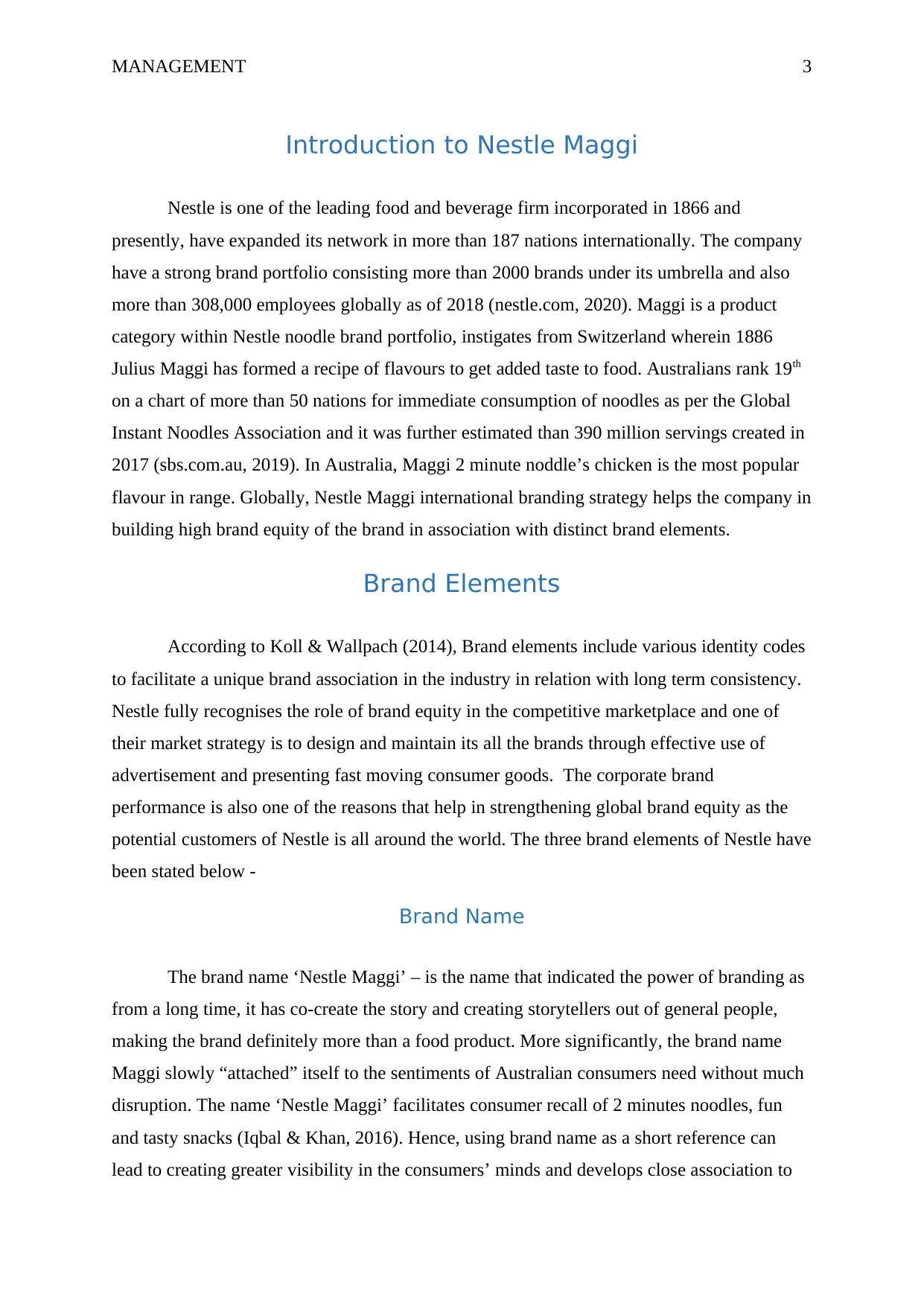
MANAGEMENT 3
Introduction to Nestle Maggi
Nestle is one of the leading food and beverage firm incorporated in 1866 and
presently, have expanded its network in more than 187 nations internationally. The company
have a strong brand portfolio consisting more than 2000 brands under its umbrella and also
more than 308,000 employees globally as of 2018 (nestle.com, 2020). Maggi is a product
category within Nestle noodle brand portfolio, instigates from Switzerland wherein 1886
Julius Maggi has formed a recipe of flavours to get added taste to food. Australians rank 19th
on a chart of more than 50 nations for immediate consumption of noodles as per the Global
Instant Noodles Association and it was further estimated than 390 million servings created in
2017 (sbs.com.au, 2019). In Australia, Maggi 2 minute noddle’s chicken is the most popular
flavour in range. Globally, Nestle Maggi international branding strategy helps the company in
building high brand equity of the brand in association with distinct brand elements.
Brand Elements
According to Koll & Wallpach (2014), Brand elements include various identity codes
to facilitate a unique brand association in the industry in relation with long term consistency.
Nestle fully recognises the role of brand equity in the competitive marketplace and one of
their market strategy is to design and maintain its all the brands through effective use of
advertisement and presenting fast moving consumer goods. The corporate brand
performance is also one of the reasons that help in strengthening global brand equity as the
potential customers of Nestle is all around the world. The three brand elements of Nestle have
been stated below -
Brand Name
The brand name ‘Nestle Maggi’ – is the name that indicated the power of branding as
from a long time, it has co-create the story and creating storytellers out of general people,
making the brand definitely more than a food product. More significantly, the brand name
Maggi slowly “attached” itself to the sentiments of Australian consumers need without much
disruption. The name ‘Nestle Maggi’ facilitates consumer recall of 2 minutes noodles, fun
and tasty snacks (Iqbal & Khan, 2016). Hence, using brand name as a short reference can
lead to creating greater visibility in the consumers’ minds and develops close association to
Introduction to Nestle Maggi
Nestle is one of the leading food and beverage firm incorporated in 1866 and
presently, have expanded its network in more than 187 nations internationally. The company
have a strong brand portfolio consisting more than 2000 brands under its umbrella and also
more than 308,000 employees globally as of 2018 (nestle.com, 2020). Maggi is a product
category within Nestle noodle brand portfolio, instigates from Switzerland wherein 1886
Julius Maggi has formed a recipe of flavours to get added taste to food. Australians rank 19th
on a chart of more than 50 nations for immediate consumption of noodles as per the Global
Instant Noodles Association and it was further estimated than 390 million servings created in
2017 (sbs.com.au, 2019). In Australia, Maggi 2 minute noddle’s chicken is the most popular
flavour in range. Globally, Nestle Maggi international branding strategy helps the company in
building high brand equity of the brand in association with distinct brand elements.
Brand Elements
According to Koll & Wallpach (2014), Brand elements include various identity codes
to facilitate a unique brand association in the industry in relation with long term consistency.
Nestle fully recognises the role of brand equity in the competitive marketplace and one of
their market strategy is to design and maintain its all the brands through effective use of
advertisement and presenting fast moving consumer goods. The corporate brand
performance is also one of the reasons that help in strengthening global brand equity as the
potential customers of Nestle is all around the world. The three brand elements of Nestle have
been stated below -
Brand Name
The brand name ‘Nestle Maggi’ – is the name that indicated the power of branding as
from a long time, it has co-create the story and creating storytellers out of general people,
making the brand definitely more than a food product. More significantly, the brand name
Maggi slowly “attached” itself to the sentiments of Australian consumers need without much
disruption. The name ‘Nestle Maggi’ facilitates consumer recall of 2 minutes noodles, fun
and tasty snacks (Iqbal & Khan, 2016). Hence, using brand name as a short reference can
lead to creating greater visibility in the consumers’ minds and develops close association to
Paraphrase This Document
Need a fresh take? Get an instant paraphrase of this document with our AI Paraphraser
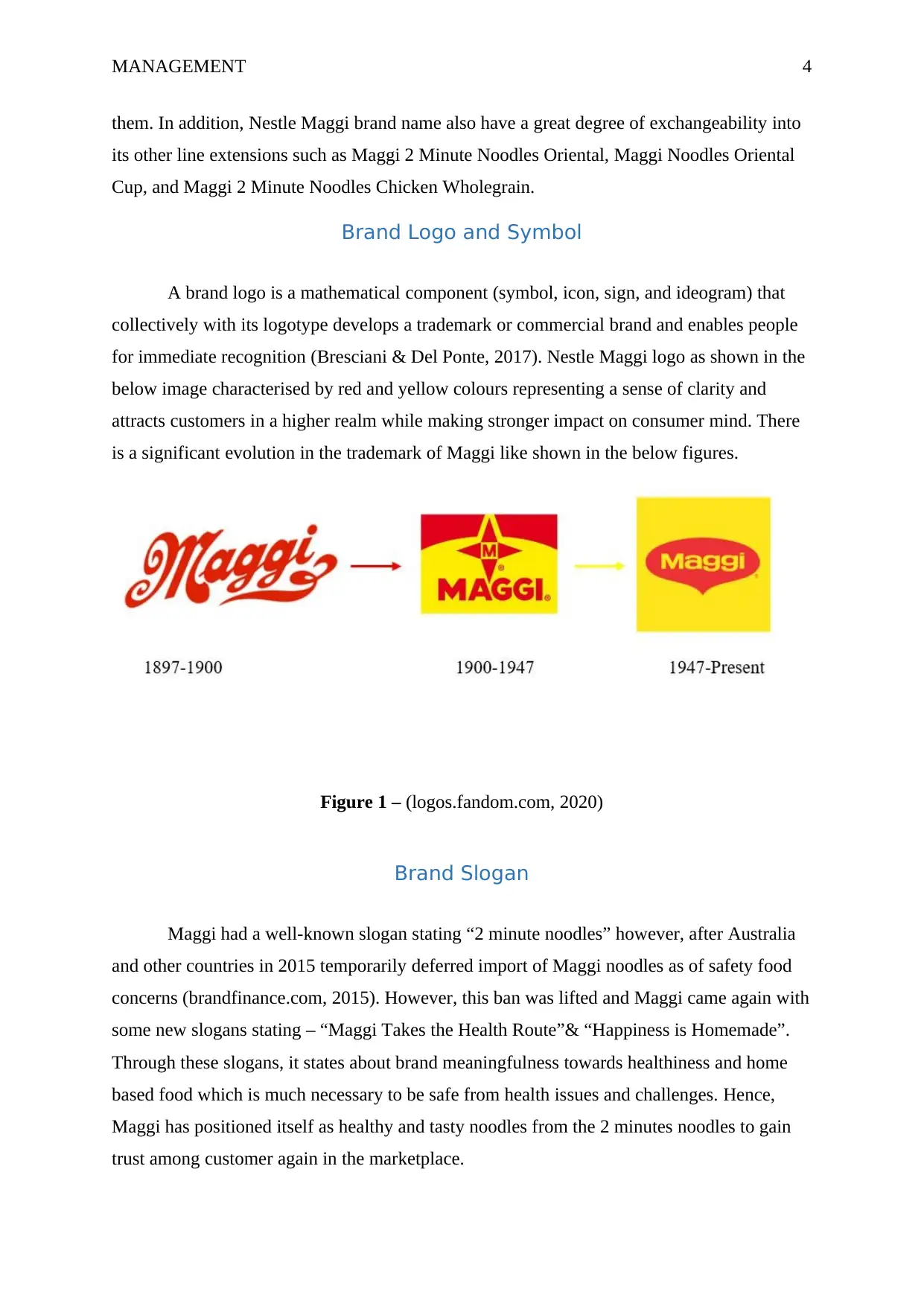
MANAGEMENT 4
them. In addition, Nestle Maggi brand name also have a great degree of exchangeability into
its other line extensions such as Maggi 2 Minute Noodles Oriental, Maggi Noodles Oriental
Cup, and Maggi 2 Minute Noodles Chicken Wholegrain.
Brand Logo and Symbol
A brand logo is a mathematical component (symbol, icon, sign, and ideogram) that
collectively with its logotype develops a trademark or commercial brand and enables people
for immediate recognition (Bresciani & Del Ponte, 2017). Nestle Maggi logo as shown in the
below image characterised by red and yellow colours representing a sense of clarity and
attracts customers in a higher realm while making stronger impact on consumer mind. There
is a significant evolution in the trademark of Maggi like shown in the below figures.
Figure 1 – (logos.fandom.com, 2020)
Brand Slogan
Maggi had a well-known slogan stating “2 minute noodles” however, after Australia
and other countries in 2015 temporarily deferred import of Maggi noodles as of safety food
concerns (brandfinance.com, 2015). However, this ban was lifted and Maggi came again with
some new slogans stating – “Maggi Takes the Health Route”& “Happiness is Homemade”.
Through these slogans, it states about brand meaningfulness towards healthiness and home
based food which is much necessary to be safe from health issues and challenges. Hence,
Maggi has positioned itself as healthy and tasty noodles from the 2 minutes noodles to gain
trust among customer again in the marketplace.
them. In addition, Nestle Maggi brand name also have a great degree of exchangeability into
its other line extensions such as Maggi 2 Minute Noodles Oriental, Maggi Noodles Oriental
Cup, and Maggi 2 Minute Noodles Chicken Wholegrain.
Brand Logo and Symbol
A brand logo is a mathematical component (symbol, icon, sign, and ideogram) that
collectively with its logotype develops a trademark or commercial brand and enables people
for immediate recognition (Bresciani & Del Ponte, 2017). Nestle Maggi logo as shown in the
below image characterised by red and yellow colours representing a sense of clarity and
attracts customers in a higher realm while making stronger impact on consumer mind. There
is a significant evolution in the trademark of Maggi like shown in the below figures.
Figure 1 – (logos.fandom.com, 2020)
Brand Slogan
Maggi had a well-known slogan stating “2 minute noodles” however, after Australia
and other countries in 2015 temporarily deferred import of Maggi noodles as of safety food
concerns (brandfinance.com, 2015). However, this ban was lifted and Maggi came again with
some new slogans stating – “Maggi Takes the Health Route”& “Happiness is Homemade”.
Through these slogans, it states about brand meaningfulness towards healthiness and home
based food which is much necessary to be safe from health issues and challenges. Hence,
Maggi has positioned itself as healthy and tasty noodles from the 2 minutes noodles to gain
trust among customer again in the marketplace.
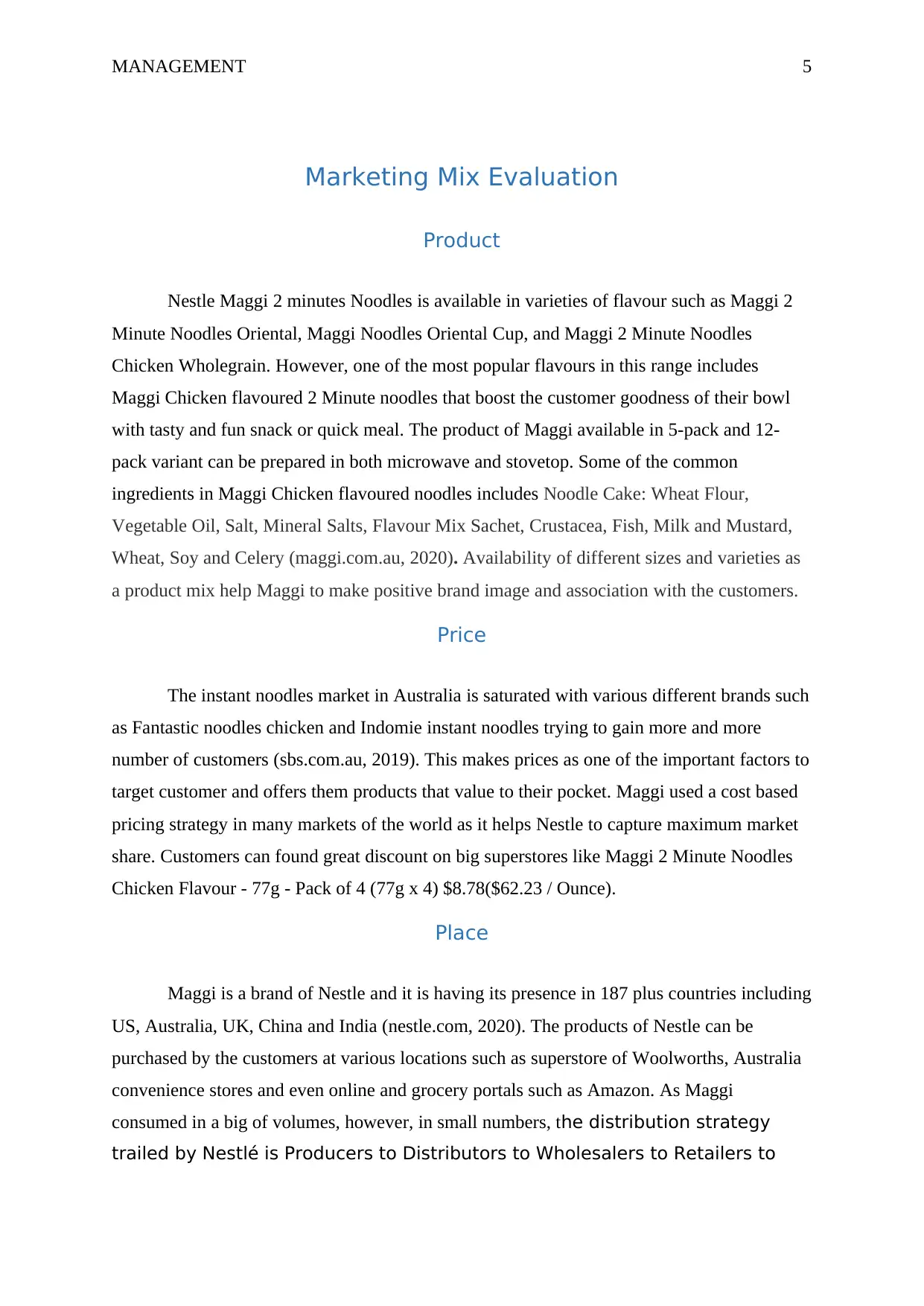
MANAGEMENT 5
Marketing Mix Evaluation
Product
Nestle Maggi 2 minutes Noodles is available in varieties of flavour such as Maggi 2
Minute Noodles Oriental, Maggi Noodles Oriental Cup, and Maggi 2 Minute Noodles
Chicken Wholegrain. However, one of the most popular flavours in this range includes
Maggi Chicken flavoured 2 Minute noodles that boost the customer goodness of their bowl
with tasty and fun snack or quick meal. The product of Maggi available in 5-pack and 12-
pack variant can be prepared in both microwave and stovetop. Some of the common
ingredients in Maggi Chicken flavoured noodles includes Noodle Cake: Wheat Flour,
Vegetable Oil, Salt, Mineral Salts, Flavour Mix Sachet, Crustacea, Fish, Milk and Mustard,
Wheat, Soy and Celery (maggi.com.au, 2020). Availability of different sizes and varieties as
a product mix help Maggi to make positive brand image and association with the customers.
Price
The instant noodles market in Australia is saturated with various different brands such
as Fantastic noodles chicken and Indomie instant noodles trying to gain more and more
number of customers (sbs.com.au, 2019). This makes prices as one of the important factors to
target customer and offers them products that value to their pocket. Maggi used a cost based
pricing strategy in many markets of the world as it helps Nestle to capture maximum market
share. Customers can found great discount on big superstores like Maggi 2 Minute Noodles
Chicken Flavour - 77g - Pack of 4 (77g x 4) $8.78($62.23 / Ounce).
Place
Maggi is a brand of Nestle and it is having its presence in 187 plus countries including
US, Australia, UK, China and India (nestle.com, 2020). The products of Nestle can be
purchased by the customers at various locations such as superstore of Woolworths, Australia
convenience stores and even online and grocery portals such as Amazon. As Maggi
consumed in a big of volumes, however, in small numbers, the distribution strategy
trailed by Nestlé is Producers to Distributors to Wholesalers to Retailers to
Marketing Mix Evaluation
Product
Nestle Maggi 2 minutes Noodles is available in varieties of flavour such as Maggi 2
Minute Noodles Oriental, Maggi Noodles Oriental Cup, and Maggi 2 Minute Noodles
Chicken Wholegrain. However, one of the most popular flavours in this range includes
Maggi Chicken flavoured 2 Minute noodles that boost the customer goodness of their bowl
with tasty and fun snack or quick meal. The product of Maggi available in 5-pack and 12-
pack variant can be prepared in both microwave and stovetop. Some of the common
ingredients in Maggi Chicken flavoured noodles includes Noodle Cake: Wheat Flour,
Vegetable Oil, Salt, Mineral Salts, Flavour Mix Sachet, Crustacea, Fish, Milk and Mustard,
Wheat, Soy and Celery (maggi.com.au, 2020). Availability of different sizes and varieties as
a product mix help Maggi to make positive brand image and association with the customers.
Price
The instant noodles market in Australia is saturated with various different brands such
as Fantastic noodles chicken and Indomie instant noodles trying to gain more and more
number of customers (sbs.com.au, 2019). This makes prices as one of the important factors to
target customer and offers them products that value to their pocket. Maggi used a cost based
pricing strategy in many markets of the world as it helps Nestle to capture maximum market
share. Customers can found great discount on big superstores like Maggi 2 Minute Noodles
Chicken Flavour - 77g - Pack of 4 (77g x 4) $8.78($62.23 / Ounce).
Place
Maggi is a brand of Nestle and it is having its presence in 187 plus countries including
US, Australia, UK, China and India (nestle.com, 2020). The products of Nestle can be
purchased by the customers at various locations such as superstore of Woolworths, Australia
convenience stores and even online and grocery portals such as Amazon. As Maggi
consumed in a big of volumes, however, in small numbers, the distribution strategy
trailed by Nestlé is Producers to Distributors to Wholesalers to Retailers to
⊘ This is a preview!⊘
Do you want full access?
Subscribe today to unlock all pages.

Trusted by 1+ million students worldwide
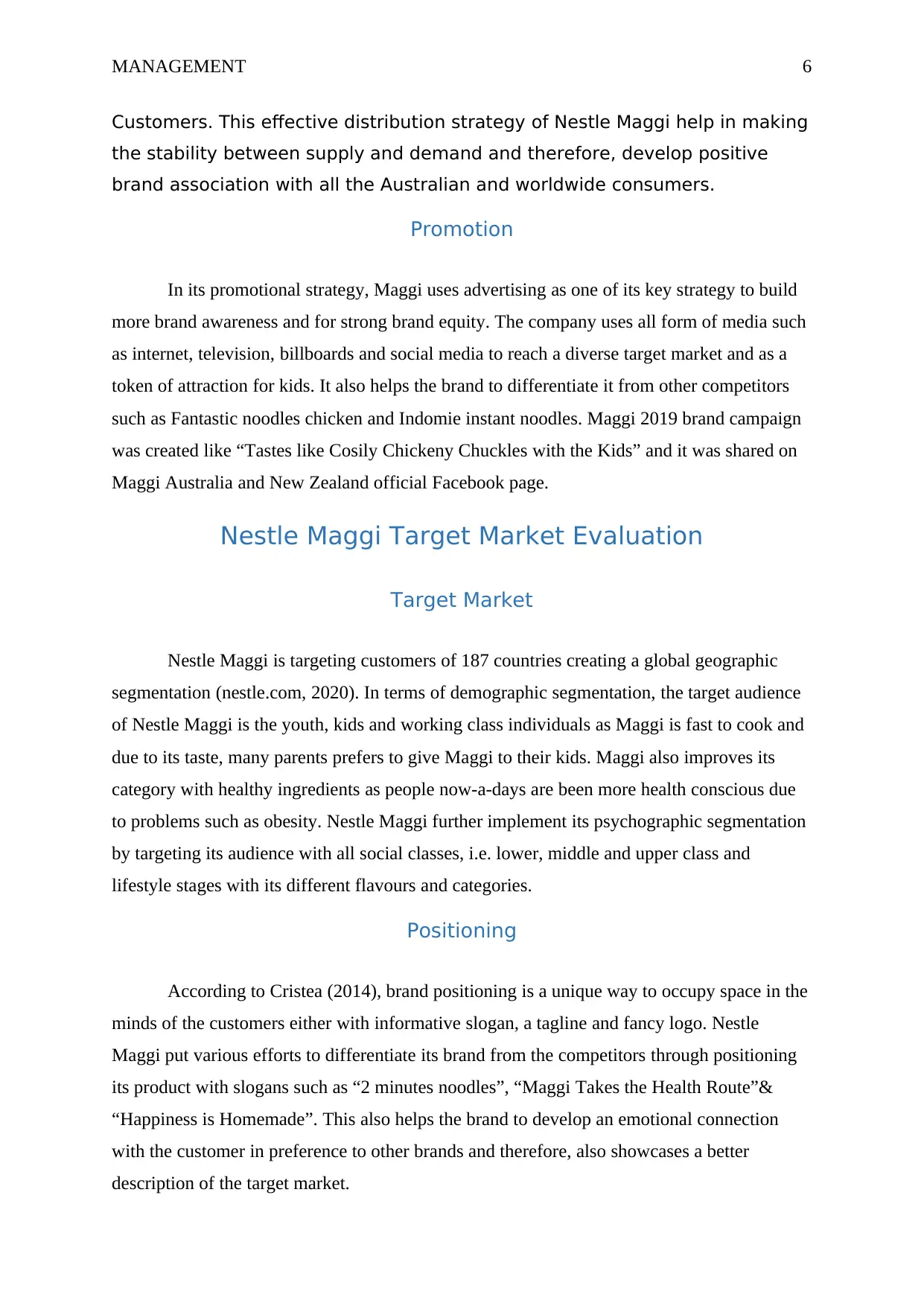
MANAGEMENT 6
Customers. This effective distribution strategy of Nestle Maggi help in making
the stability between supply and demand and therefore, develop positive
brand association with all the Australian and worldwide consumers.
Promotion
In its promotional strategy, Maggi uses advertising as one of its key strategy to build
more brand awareness and for strong brand equity. The company uses all form of media such
as internet, television, billboards and social media to reach a diverse target market and as a
token of attraction for kids. It also helps the brand to differentiate it from other competitors
such as Fantastic noodles chicken and Indomie instant noodles. Maggi 2019 brand campaign
was created like “Tastes like Cosily Chickeny Chuckles with the Kids” and it was shared on
Maggi Australia and New Zealand official Facebook page.
Nestle Maggi Target Market Evaluation
Target Market
Nestle Maggi is targeting customers of 187 countries creating a global geographic
segmentation (nestle.com, 2020). In terms of demographic segmentation, the target audience
of Nestle Maggi is the youth, kids and working class individuals as Maggi is fast to cook and
due to its taste, many parents prefers to give Maggi to their kids. Maggi also improves its
category with healthy ingredients as people now-a-days are been more health conscious due
to problems such as obesity. Nestle Maggi further implement its psychographic segmentation
by targeting its audience with all social classes, i.e. lower, middle and upper class and
lifestyle stages with its different flavours and categories.
Positioning
According to Cristea (2014), brand positioning is a unique way to occupy space in the
minds of the customers either with informative slogan, a tagline and fancy logo. Nestle
Maggi put various efforts to differentiate its brand from the competitors through positioning
its product with slogans such as “2 minutes noodles”, “Maggi Takes the Health Route”&
“Happiness is Homemade”. This also helps the brand to develop an emotional connection
with the customer in preference to other brands and therefore, also showcases a better
description of the target market.
Customers. This effective distribution strategy of Nestle Maggi help in making
the stability between supply and demand and therefore, develop positive
brand association with all the Australian and worldwide consumers.
Promotion
In its promotional strategy, Maggi uses advertising as one of its key strategy to build
more brand awareness and for strong brand equity. The company uses all form of media such
as internet, television, billboards and social media to reach a diverse target market and as a
token of attraction for kids. It also helps the brand to differentiate it from other competitors
such as Fantastic noodles chicken and Indomie instant noodles. Maggi 2019 brand campaign
was created like “Tastes like Cosily Chickeny Chuckles with the Kids” and it was shared on
Maggi Australia and New Zealand official Facebook page.
Nestle Maggi Target Market Evaluation
Target Market
Nestle Maggi is targeting customers of 187 countries creating a global geographic
segmentation (nestle.com, 2020). In terms of demographic segmentation, the target audience
of Nestle Maggi is the youth, kids and working class individuals as Maggi is fast to cook and
due to its taste, many parents prefers to give Maggi to their kids. Maggi also improves its
category with healthy ingredients as people now-a-days are been more health conscious due
to problems such as obesity. Nestle Maggi further implement its psychographic segmentation
by targeting its audience with all social classes, i.e. lower, middle and upper class and
lifestyle stages with its different flavours and categories.
Positioning
According to Cristea (2014), brand positioning is a unique way to occupy space in the
minds of the customers either with informative slogan, a tagline and fancy logo. Nestle
Maggi put various efforts to differentiate its brand from the competitors through positioning
its product with slogans such as “2 minutes noodles”, “Maggi Takes the Health Route”&
“Happiness is Homemade”. This also helps the brand to develop an emotional connection
with the customer in preference to other brands and therefore, also showcases a better
description of the target market.
Paraphrase This Document
Need a fresh take? Get an instant paraphrase of this document with our AI Paraphraser
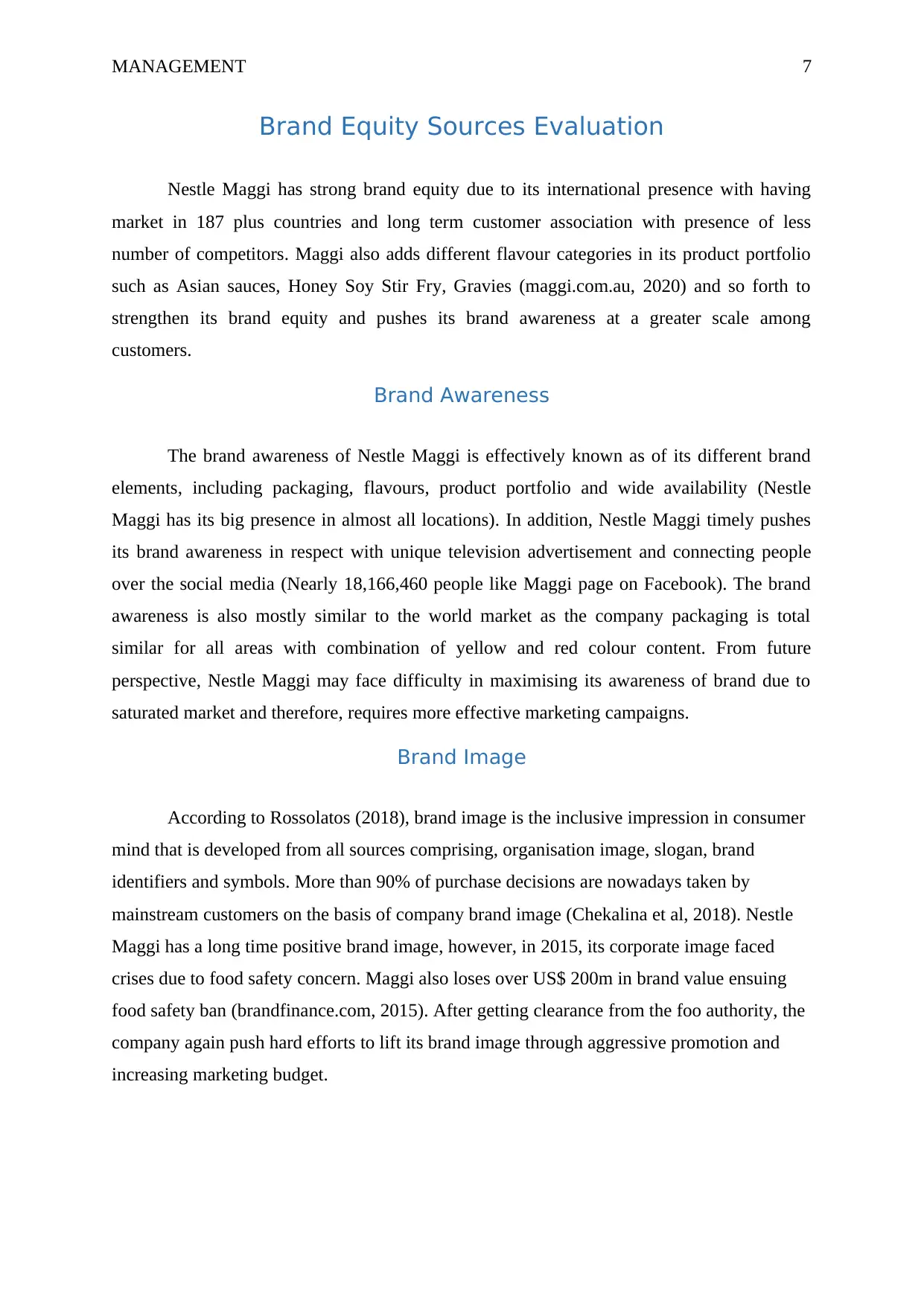
MANAGEMENT 7
Brand Equity Sources Evaluation
Nestle Maggi has strong brand equity due to its international presence with having
market in 187 plus countries and long term customer association with presence of less
number of competitors. Maggi also adds different flavour categories in its product portfolio
such as Asian sauces, Honey Soy Stir Fry, Gravies (maggi.com.au, 2020) and so forth to
strengthen its brand equity and pushes its brand awareness at a greater scale among
customers.
Brand Awareness
The brand awareness of Nestle Maggi is effectively known as of its different brand
elements, including packaging, flavours, product portfolio and wide availability (Nestle
Maggi has its big presence in almost all locations). In addition, Nestle Maggi timely pushes
its brand awareness in respect with unique television advertisement and connecting people
over the social media (Nearly 18,166,460 people like Maggi page on Facebook). The brand
awareness is also mostly similar to the world market as the company packaging is total
similar for all areas with combination of yellow and red colour content. From future
perspective, Nestle Maggi may face difficulty in maximising its awareness of brand due to
saturated market and therefore, requires more effective marketing campaigns.
Brand Image
According to Rossolatos (2018), brand image is the inclusive impression in consumer
mind that is developed from all sources comprising, organisation image, slogan, brand
identifiers and symbols. More than 90% of purchase decisions are nowadays taken by
mainstream customers on the basis of company brand image (Chekalina et al, 2018). Nestle
Maggi has a long time positive brand image, however, in 2015, its corporate image faced
crises due to food safety concern. Maggi also loses over US$ 200m in brand value ensuing
food safety ban (brandfinance.com, 2015). After getting clearance from the foo authority, the
company again push hard efforts to lift its brand image through aggressive promotion and
increasing marketing budget.
Brand Equity Sources Evaluation
Nestle Maggi has strong brand equity due to its international presence with having
market in 187 plus countries and long term customer association with presence of less
number of competitors. Maggi also adds different flavour categories in its product portfolio
such as Asian sauces, Honey Soy Stir Fry, Gravies (maggi.com.au, 2020) and so forth to
strengthen its brand equity and pushes its brand awareness at a greater scale among
customers.
Brand Awareness
The brand awareness of Nestle Maggi is effectively known as of its different brand
elements, including packaging, flavours, product portfolio and wide availability (Nestle
Maggi has its big presence in almost all locations). In addition, Nestle Maggi timely pushes
its brand awareness in respect with unique television advertisement and connecting people
over the social media (Nearly 18,166,460 people like Maggi page on Facebook). The brand
awareness is also mostly similar to the world market as the company packaging is total
similar for all areas with combination of yellow and red colour content. From future
perspective, Nestle Maggi may face difficulty in maximising its awareness of brand due to
saturated market and therefore, requires more effective marketing campaigns.
Brand Image
According to Rossolatos (2018), brand image is the inclusive impression in consumer
mind that is developed from all sources comprising, organisation image, slogan, brand
identifiers and symbols. More than 90% of purchase decisions are nowadays taken by
mainstream customers on the basis of company brand image (Chekalina et al, 2018). Nestle
Maggi has a long time positive brand image, however, in 2015, its corporate image faced
crises due to food safety concern. Maggi also loses over US$ 200m in brand value ensuing
food safety ban (brandfinance.com, 2015). After getting clearance from the foo authority, the
company again push hard efforts to lift its brand image through aggressive promotion and
increasing marketing budget.
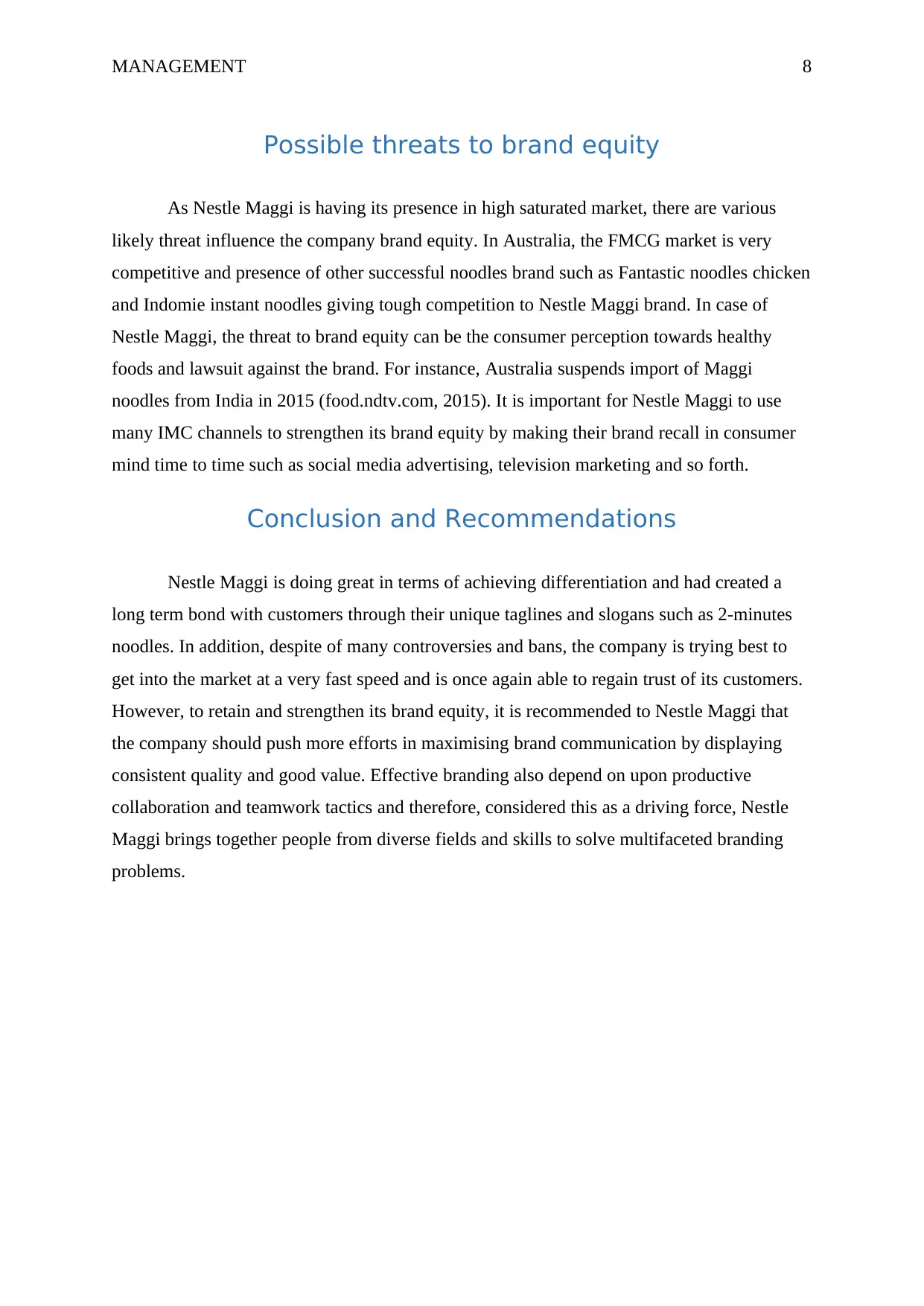
MANAGEMENT 8
Possible threats to brand equity
As Nestle Maggi is having its presence in high saturated market, there are various
likely threat influence the company brand equity. In Australia, the FMCG market is very
competitive and presence of other successful noodles brand such as Fantastic noodles chicken
and Indomie instant noodles giving tough competition to Nestle Maggi brand. In case of
Nestle Maggi, the threat to brand equity can be the consumer perception towards healthy
foods and lawsuit against the brand. For instance, Australia suspends import of Maggi
noodles from India in 2015 (food.ndtv.com, 2015). It is important for Nestle Maggi to use
many IMC channels to strengthen its brand equity by making their brand recall in consumer
mind time to time such as social media advertising, television marketing and so forth.
Conclusion and Recommendations
Nestle Maggi is doing great in terms of achieving differentiation and had created a
long term bond with customers through their unique taglines and slogans such as 2-minutes
noodles. In addition, despite of many controversies and bans, the company is trying best to
get into the market at a very fast speed and is once again able to regain trust of its customers.
However, to retain and strengthen its brand equity, it is recommended to Nestle Maggi that
the company should push more efforts in maximising brand communication by displaying
consistent quality and good value. Effective branding also depend on upon productive
collaboration and teamwork tactics and therefore, considered this as a driving force, Nestle
Maggi brings together people from diverse fields and skills to solve multifaceted branding
problems.
Possible threats to brand equity
As Nestle Maggi is having its presence in high saturated market, there are various
likely threat influence the company brand equity. In Australia, the FMCG market is very
competitive and presence of other successful noodles brand such as Fantastic noodles chicken
and Indomie instant noodles giving tough competition to Nestle Maggi brand. In case of
Nestle Maggi, the threat to brand equity can be the consumer perception towards healthy
foods and lawsuit against the brand. For instance, Australia suspends import of Maggi
noodles from India in 2015 (food.ndtv.com, 2015). It is important for Nestle Maggi to use
many IMC channels to strengthen its brand equity by making their brand recall in consumer
mind time to time such as social media advertising, television marketing and so forth.
Conclusion and Recommendations
Nestle Maggi is doing great in terms of achieving differentiation and had created a
long term bond with customers through their unique taglines and slogans such as 2-minutes
noodles. In addition, despite of many controversies and bans, the company is trying best to
get into the market at a very fast speed and is once again able to regain trust of its customers.
However, to retain and strengthen its brand equity, it is recommended to Nestle Maggi that
the company should push more efforts in maximising brand communication by displaying
consistent quality and good value. Effective branding also depend on upon productive
collaboration and teamwork tactics and therefore, considered this as a driving force, Nestle
Maggi brings together people from diverse fields and skills to solve multifaceted branding
problems.
⊘ This is a preview!⊘
Do you want full access?
Subscribe today to unlock all pages.

Trusted by 1+ million students worldwide
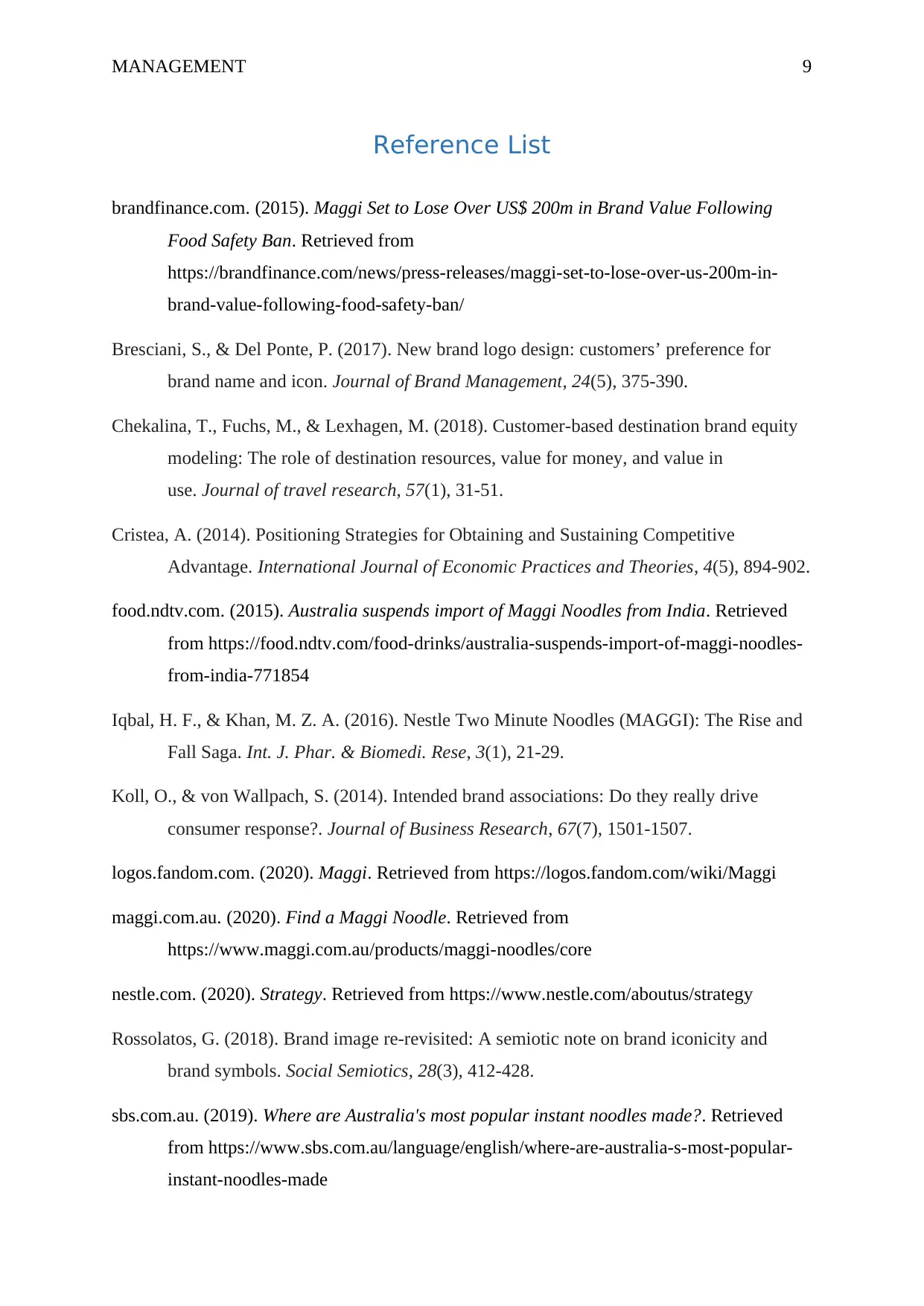
MANAGEMENT 9
Reference List
brandfinance.com. (2015). Maggi Set to Lose Over US$ 200m in Brand Value Following
Food Safety Ban. Retrieved from
https://brandfinance.com/news/press-releases/maggi-set-to-lose-over-us-200m-in-
brand-value-following-food-safety-ban/
Bresciani, S., & Del Ponte, P. (2017). New brand logo design: customers’ preference for
brand name and icon. Journal of Brand Management, 24(5), 375-390.
Chekalina, T., Fuchs, M., & Lexhagen, M. (2018). Customer-based destination brand equity
modeling: The role of destination resources, value for money, and value in
use. Journal of travel research, 57(1), 31-51.
Cristea, A. (2014). Positioning Strategies for Obtaining and Sustaining Competitive
Advantage. International Journal of Economic Practices and Theories, 4(5), 894-902.
food.ndtv.com. (2015). Australia suspends import of Maggi Noodles from India. Retrieved
from https://food.ndtv.com/food-drinks/australia-suspends-import-of-maggi-noodles-
from-india-771854
Iqbal, H. F., & Khan, M. Z. A. (2016). Nestle Two Minute Noodles (MAGGI): The Rise and
Fall Saga. Int. J. Phar. & Biomedi. Rese, 3(1), 21-29.
Koll, O., & von Wallpach, S. (2014). Intended brand associations: Do they really drive
consumer response?. Journal of Business Research, 67(7), 1501-1507.
logos.fandom.com. (2020). Maggi. Retrieved from https://logos.fandom.com/wiki/Maggi
maggi.com.au. (2020). Find a Maggi Noodle. Retrieved from
https://www.maggi.com.au/products/maggi-noodles/core
nestle.com. (2020). Strategy. Retrieved from https://www.nestle.com/aboutus/strategy
Rossolatos, G. (2018). Brand image re-revisited: A semiotic note on brand iconicity and
brand symbols. Social Semiotics, 28(3), 412-428.
sbs.com.au. (2019). Where are Australia's most popular instant noodles made?. Retrieved
from https://www.sbs.com.au/language/english/where-are-australia-s-most-popular-
instant-noodles-made
Reference List
brandfinance.com. (2015). Maggi Set to Lose Over US$ 200m in Brand Value Following
Food Safety Ban. Retrieved from
https://brandfinance.com/news/press-releases/maggi-set-to-lose-over-us-200m-in-
brand-value-following-food-safety-ban/
Bresciani, S., & Del Ponte, P. (2017). New brand logo design: customers’ preference for
brand name and icon. Journal of Brand Management, 24(5), 375-390.
Chekalina, T., Fuchs, M., & Lexhagen, M. (2018). Customer-based destination brand equity
modeling: The role of destination resources, value for money, and value in
use. Journal of travel research, 57(1), 31-51.
Cristea, A. (2014). Positioning Strategies for Obtaining and Sustaining Competitive
Advantage. International Journal of Economic Practices and Theories, 4(5), 894-902.
food.ndtv.com. (2015). Australia suspends import of Maggi Noodles from India. Retrieved
from https://food.ndtv.com/food-drinks/australia-suspends-import-of-maggi-noodles-
from-india-771854
Iqbal, H. F., & Khan, M. Z. A. (2016). Nestle Two Minute Noodles (MAGGI): The Rise and
Fall Saga. Int. J. Phar. & Biomedi. Rese, 3(1), 21-29.
Koll, O., & von Wallpach, S. (2014). Intended brand associations: Do they really drive
consumer response?. Journal of Business Research, 67(7), 1501-1507.
logos.fandom.com. (2020). Maggi. Retrieved from https://logos.fandom.com/wiki/Maggi
maggi.com.au. (2020). Find a Maggi Noodle. Retrieved from
https://www.maggi.com.au/products/maggi-noodles/core
nestle.com. (2020). Strategy. Retrieved from https://www.nestle.com/aboutus/strategy
Rossolatos, G. (2018). Brand image re-revisited: A semiotic note on brand iconicity and
brand symbols. Social Semiotics, 28(3), 412-428.
sbs.com.au. (2019). Where are Australia's most popular instant noodles made?. Retrieved
from https://www.sbs.com.au/language/english/where-are-australia-s-most-popular-
instant-noodles-made
1 out of 10
Related Documents
Your All-in-One AI-Powered Toolkit for Academic Success.
+13062052269
info@desklib.com
Available 24*7 on WhatsApp / Email
![[object Object]](/_next/static/media/star-bottom.7253800d.svg)
Unlock your academic potential
Copyright © 2020–2025 A2Z Services. All Rights Reserved. Developed and managed by ZUCOL.





